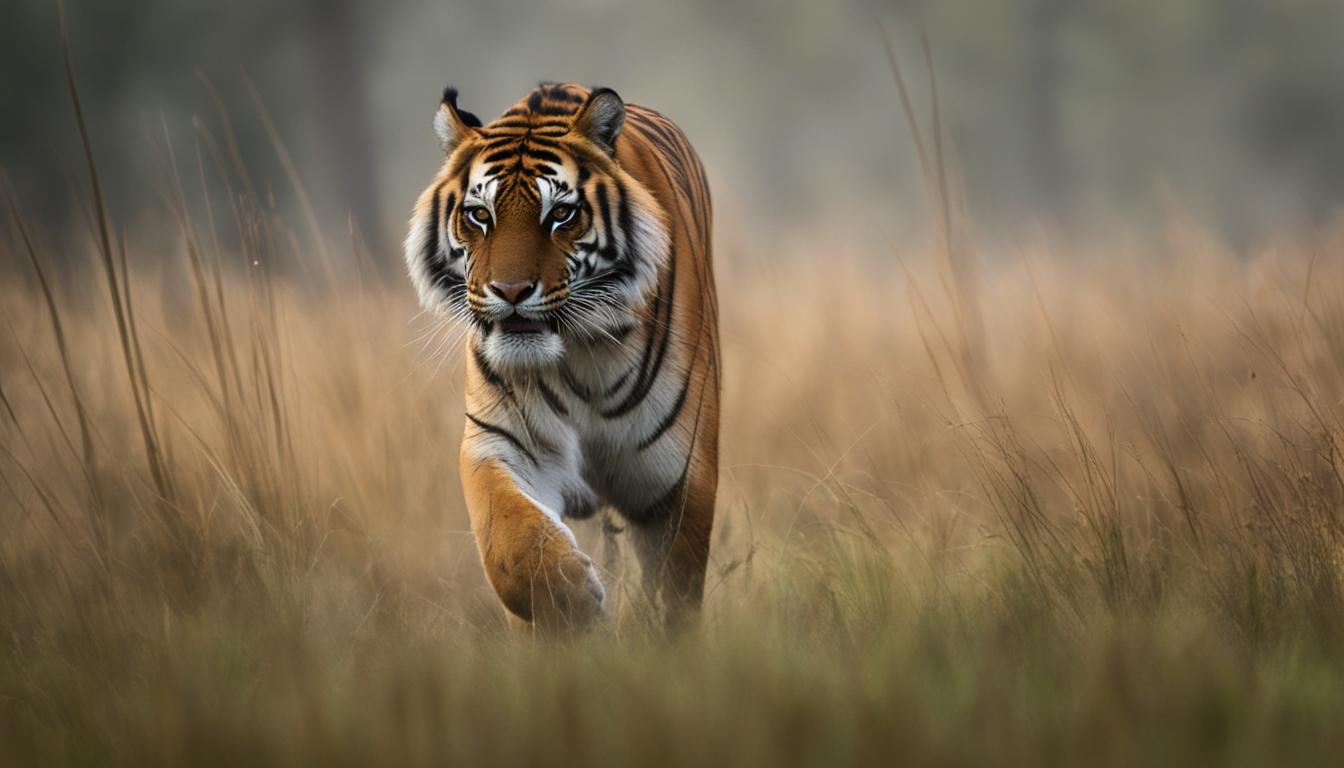When it comes to hunting, tigers are masters of strategy and skill. These majestic creatures have developed effective tactics and techniques for tracking and capturing their prey. Whether it’s stalking their target with expert precision or employing innovative tactics to ensure a successful hunt, tigers have honed their hunting abilities through generations of natural selection.
Tigers often rely on their size and strength to overpower their prey. They employ a silent approach, using their camouflage and stealth to get close to their target without being detected. Once within range, tigers make a lightning-fast leap, aiming for the neck or nape of their prey. Their powerful jaws deliver a fatal bite, often breaking the prey’s spinal cord.
While tigers have a preference for certain prey species, they are not limited to hunting small animals. Tigers are known to take down larger animals, showcasing their skilled approaches and successful methods. Additionally, tigers have been observed hunting while swimming and have even been known to ambush boats for food.
Tigers typically hunt between dusk and dawn, utilizing the cover of darkness to their advantage. They may cover unfinished meals, allowing them to return later to consume what remains. It’s important to note that while tigers rarely hunt humans, injured or ill tigers may resort to targeting humans as prey.
Key Takeaways:
- Tigers employ a silent approach and rely on camouflage to get close to their prey undetected.
- Their powerful bite, aimed at the neck or nape, often results in a broken spinal cord.
- Tigers have a preference for certain prey species but can hunt larger animals as well.
- They hunt between dusk and dawn, utilizing the cover of darkness for a successful ambush.
- Injured or ill tigers may resort to targeting humans as prey.
The Stages of Tiger Hunting
Tigers employ a systematic approach when hunting for prey. The hunting process can be broken down into sequential steps that showcase their expert hunting skills and predatory instincts.
First, tigers search for potential prey, often focusing on watering holes where herbivores gather to drink. Once they have identified a target, tigers initiate a silent approach, relying on their exceptional camouflage and stealthy movements to get as close as possible without being detected.
Once within striking distance, tigers execute a lightning-fast leap to take down their prey. They aim for the prey’s neck or nape, delivering a powerful bite that often breaks the spinal cord, ensuring a swift and efficient kill.
After successfully capturing their prey, tigers move the carcass to a safe location where they can eat undisturbed. This behavior helps them avoid interference from scavengers and ensures they can consume their meal without interruption.
The Stages of Tiger Hunting Table
| Stage | Description |
|---|---|
| Search for Prey | Tigers target watering holes and actively search for potential prey. |
| Silent Approach | Tigers utilize their camouflage and stealth to get close to the prey without being detected. |
| Fast Leap and Attack | Tigers execute a rapid leap to take down the prey, aiming for the neck or nape for a quick kill. |
| Move Carcass to Safe Location | Tigers relocate the captured prey to a secure area where they can eat undisturbed. |
Training and Learning to Hunt
Tiger cubs have the unique advantage of learning hunting skills from their mother from a young age. Through a gradual process, the mother introduces the cubs to fresh meat and teaches them the techniques necessary for successful hunting. As the cubs grow, they accompany their mother on hunting expeditions, observing and mimicking her every move. This hands-on approach allows them to develop the necessary skills and instincts to become proficient hunters.
During playtime with their siblings, tiger cubs engage in playful fights that involve pouncing and stalking. These interactions serve as practice sessions, honing their hunting abilities. Through these play fights, they learn about the importance of stealth, agility, and precision in capturing prey. The playful nature of these interactions instills a sense of enjoyment and reinforces their natural instincts as predators.
By the time tiger cubs reach adulthood, they have gone through a comprehensive training process that equips them with the skills they need to excel in the art of hunting. They have learned the importance of patience, strategy, and execution. The knowledge passed down by their mother, combined with their own experiences, prepares them for the challenges they will face as independent hunters in the wild.
| Hunting Lessons for Tiger Cubs | Skills Learned |
|---|---|
| Introduction to fresh meat | Understanding the taste and texture of prey |
| Accompanying mother on hunting expeditions | Observing and imitating hunting techniques |
| Playful fights with siblings | Developing stalking and pouncing skills |
| Gradual progression to independent hunting | Applying learned skills in real hunting scenarios |
The training and learning process of tiger cubs ensures a smooth transition into adulthood, setting the foundation for their survival and success as apex predators.
Tiger Hunting in Captivity and Enrichment
While tigers in the wild have the opportunity to exercise their hunting skills naturally, those in captivity require unique enrichment activities to satisfy their instincts. Zookeepers employ various methods to simulate hunting experiences for captive tigers, allowing them to engage in natural behaviors and stay mentally stimulated.
Hunting Enrichment for Captive Tigers
Live prey is not introduced to tigers in captivity for ethical and safety reasons. Instead, zookeepers provide artificial prey experiences that mimic the excitement of a hunt. One popular method is using large balls, which tigers can chase and interact with, replicating the pursuit of prey. This activity helps keep the tigers physically active and mentally engaged.
“Providing hunting enrichments for captive tigers is crucial for their overall well-being,” says Dr. Emily Wilson, a zoologist specializing in animal behavior. “It allows them to express their natural hunting instincts and helps prevent boredom and frustration.”
In addition to using balls, some zoos animate animal carcasses or create prey species out of cardboard, reinforcing the tiger’s hunting skills. These enrichments are carefully designed to encourage stalking, pouncing, and other hunting behaviors, keeping the tigers physically fit and mentally stimulated.
Simulated Hunting Experiences for Tigers
Another method used in captivity is providing simulated hunting experiences for tigers. This involves strategically hiding food throughout the enclosure to encourage the tigers to search, stalk, and locate their meals, just as they would in the wild. This activity taps into the tiger’s natural instincts and provides mental and physical stimulation.
By offering hunting enrichments and simulated experiences, zookeepers strive to provide captive tigers with a fulfilling and engaging environment. These activities not only meet the tigers’ instinctual needs but also contribute to their overall well-being in captivity.
| Enrichment Activity | Description |
|---|---|
| Chase the Ball | Tigers are given large balls to chase and interact with, replicating the pursuit of prey. |
| Animated Carcasses | Zookeepers animate animal carcasses to mimic natural prey movements, stimulating the tiger’s hunting instincts. |
| Cardboard Prey Species | Prey species are created out of cardboard, allowing tigers to engage in stalking and pouncing behaviors. |
| Simulated Food Hunts | Food is strategically hidden throughout the enclosure, encouraging the tigers to search, stalk, and locate their meals. |
Tiger’s Daily Routine
Tigers have a structured daily routine that revolves around hunting, resting, and patrolling their territory. Let’s take a closer look at a typical day in the life of a tiger.
- Morning: As the sun rises, tigers wake from their slumber and begin their day. They start by carefully surveying their territory boundaries, ensuring that no intruders have encroached upon their domain.
- Daytime: Tigers spend much of their day moving around their habitat, patrolling and marking their territory. They take moments to rest, often lounging on grassy areas beneath the shade of trees. They may also visit nearby water sources to quench their thirst and cool off in hot weather.
- Evening: As evening approaches and the temperature cools, tigers become more active and their hunting instincts kick in. They start roaming their territory, utilizing their excellent camouflage and stealthy movements to search for prey.
- Night: Once a tiger successfully captures its prey, it consumes the meal over several days, ensuring it has enough sustenance to sustain its energy levels. Tigers are known to be opportunistic hunters, adapting their eating patterns to the availability of food.
This daily routine helps tigers maintain their strength and survival in their natural environment. It allows them to balance their energy expenditure with their hunting needs, ensuring they have the best chance of capturing their prey.
Table: A Day in the Life of a Tiger
| Time | Activity |
|---|---|
| Morning | Surveying territory boundaries |
| Daytime | Moving around, resting, and visiting water sources |
| Evening | Roaming and searching for prey |
| Night | Consuming captured prey over several days |
The Tiger’s Diet
Tigers, as carnivores, have a diet that consists solely of meat. They are formidable predators and have a preference for certain prey species. While they are capable of hunting various animals, some of their favorite prey includes deer species such as chital and sambar. These deer provide a substantial source of nutrition for tigers and are often targeted during hunts.
Tigers typically make a kill once a week, which can weigh up to 40 kilograms. Once a successful kill has been made, tigers will consume their meal over several days, ensuring they have enough energy to sustain themselves until their next hunt. Their ability to consume large amounts of food in one sitting is a testament to their strength and hunting prowess.
“Tigers are skilled hunters and top predators in their ecosystems.”
With their powerful physique and sharp hunting instincts, tigers are well-equipped to secure their place at the top of the food chain. Their carnivorous diet and hunting techniques showcase their ability to thrive in their natural habitat.
| Tiger’s Diet | Description |
|---|---|
| Prey Species | Tigers have a preference for deer species such as chital and sambar. These prey species provide a substantial source of nutrition. |
| Frequency of Kill | Tigers typically make a kill once a week, ensuring they have enough food to sustain themselves until their next hunt. |
| Amount Consumed | Tigers can consume up to 40 kilograms of food in a single sitting, allowing them to replenish their energy levels. |
| Hunting Prowess | Tigers’ carnivorous diet and hunting techniques highlight their position as skilled predators and top hunters in their ecosystems. |
Conclusion
Tigers are remarkable predators, employing a variety of hunting strategies and techniques to ensure successful captures. Their predatory behavior showcases their exceptional skill and efficiency in the wild.
Through a combination of strength, stealth, and camouflage, tigers are able to ambush their prey, often targeting vulnerable spots on the neck or nape to swiftly take them down. Their training begins at a young age, as mother tigers pass down their hunting knowledge to their cubs, teaching them the essential skills needed to become proficient hunters.
In captivity, zookeepers provide enrichment activities that simulate hunting experiences for captive tigers. Although live prey is not introduced, artificial prey encounters such as chasing large balls or interacting with animatronic carcasses allow these magnificent animals to engage in natural behaviors and exercise their hunting skills.
Overall, the hunting strategies and techniques of tigers highlight their remarkable adaptability and prowess as top predators. Whether in the wild or captivity, their ability to hunt effectively is an essential aspect of their survival and demonstrates their status as one of nature’s most formidable predators.
Are the Hunting Tactics Used by Lions and Tigers Similar?
The tactics used by lions in hunting differ from those employed by tigers. Lions usually hunt in groups called prides, using cooperative strategies to take down prey. On the other hand, tigers are solitary hunters, relying on their exceptional strength and stealth to ambush their prey. Although both feline predators are skilled hunters, their tactics diverge due to their distinct social behaviors.
FAQ
What tactics do tigers use when hunting for prey?
Tigers employ a range of tactics and strategies in their hunting behavior. They utilize their strength, stealth, and camouflage to successfully hunt their prey.
What are the stages of tiger hunting?
The stages of tiger hunting include searching for prey, silent approach, fast leap to take down the prey, moving the carcass to a safe location, and consuming the meal over several days.
How do tiger cubs learn to hunt?
Tiger cubs learn hunting skills from their mother starting at a young age. She introduces them to fresh meat and gradually teaches them how to hunt. They accompany their mother on hunting expeditions, learning through observation and mimicking her techniques.
How do captive tigers satisfy their hunting instincts?
In captivity, zookeepers use various methods to satisfy tigers’ hunting instincts. They create artificial prey experiences, such as using large balls for tigers to chase and interact with. Other methods include animating animal carcasses or creating prey species out of cardboard.
What is the daily routine of a tiger?
Tigers have a daily routine that incorporates hunting, resting, and patrolling their territory. They typically wake up from naps to survey their territory boundaries, move around their habitat, rest on grass, and visit water sources to refresh themselves.
What do tigers eat?
Tigers are carnivores, and their diet varies depending on the availability of prey in their habitat. While they can eat various animals, they have a preference for deer species such as chital and sambar.
What do the hunting techniques and behaviors of tigers showcase?
The hunting techniques and behaviors of tigers showcase their prowess as skilled and efficient predators in the wild.











